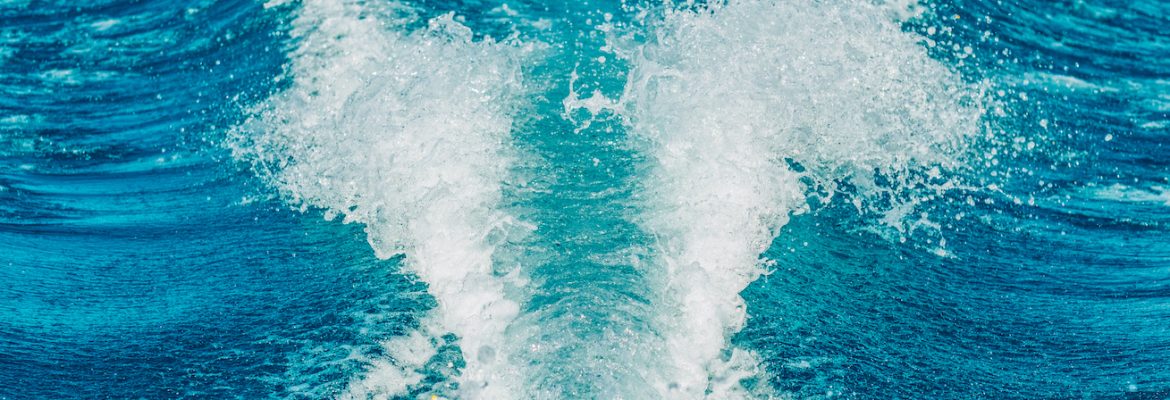by Daniel l. Dolgin
Like wines, some wakes are good and some not so good; too much in the wrong place, very bad.
Wakes unleash energy generated by a motorboat hull pushing water out of its own way. This is called displacement. In some cases, the force of the wake erodes the shoreline, re-suspends sediments that should remain on the bottom, and adversely affects other boats on the lake.
The largest and most destructive wakes come not from boats planning along at a high speed nor those traveling slowly at headway speed, but rather from boats going a medium speed – worst at six to twelve miles-per-hour – more than headway speed but not fast enough to plane. At those speeds, the bow points up, the prop points down and a larger portion of the hull is under the water line, causing significant water displacement as the boat moves forward.
This perfect storm of wake-making generates at the same time the biggest wakes and the largest funnel of disruption from the thrust of the prop wash. In water less than twenty feet deep, that prop wash, aimed down as the bow aims up, can disturb the lake bottom, destroying aquatic vegetation and pushing phosphates out from their silt-blanketed rest into the body of the lake.
Wake boats, designed to maximize wakes for the entertainment of the boaters, maximize the most destructive wakes and bottom scouring prop thrust.
The threat of wakes to our environment has been increasingly identified as a concern to those who study the health of our lakes, such as Don Griggs, of the Kezar Lake Watershed Association (KLWA). He has prepared a tremendously informative presentation on the subject for the KLWA, which you can find here: http://klwa.us/reports-and-surveys/. Don has taken his presentation to other lake groups dedicated to protecting our lakes. His email is griggsd@aol.com.
The energy force of a wave, such as a boat wake, decays slowly – by half for every eightfold increase in distance from the aquatic path of its origin. A wake that is four feet in height when a wake boat cuts through the water, will be two feet in height at 140-foot distance from each of the port and starboard sides of the boat that made the wake. At eight times that distance– at 1,280 feet from the stern of the wake-making boat – the wake will be down by half again, to one foot in height. Don Griggs’ presentation provides helpful detail showing the effects of wakes by height and their decreasing impact (decay) as they move through the water.
Maine law prohibits power boats from operating at more than headway speed within 200 feet of lake shorelines, except while actively fishing or while following a direct course to pick up or drop off skiers. A large wake, however, can wreak mighty damage at much greater than 200-foot distance. A wake four-feet high in its original form (not unusual for a wake boat wake) will decay to one foot in height at 1,280 feet port and starboard of the boat’s path. A three-foot wake will decay down to just more than a foot high at 400 feet.
In the ocean or a large, wide lake with plenty of deep water, such as Sebago, wakes generated away from shore and away from canoes and kayaks and other small craft, have little if any adverse effect on people or the environment.
But what does this wake and prop-thrust pattern mean to boat usage on Moose Pond? Because Moose Pond is relatively narrow, and much of it is less than twenty-feet deep, there is a relatively small area of our lake in which the generation of sizeable wakes will not do significant damage to our shoreline and lake bottom. When we search our lake for water more than, say, 500-600 feet from the shoreline and more than twenty-feet deep, we find only a relatively small, elliptically shaped area in the middle basin (and perhaps an even smaller area near Camp Winona). On good-weather weekends in July and August, those areas are populated with small boats, further restricting where one can generate a large wake without doing injury to our lake and neighbors.
If we get the word out, and our community of boaters shares this knowledge, careful compliance with common sense should lead us to restrain our wake-generating impulses. The rule of reason is not very complicated: Unless the lake is frozen, don’t run your power boat between six and twelve miles-an-hour (or a wake boat at any speed) for any extended time, except in water that is (i) more than twenty-feet deep, and (ii) at least 500 – 600 feet from a shoreline, and (iii) as far as possible from small craft.

